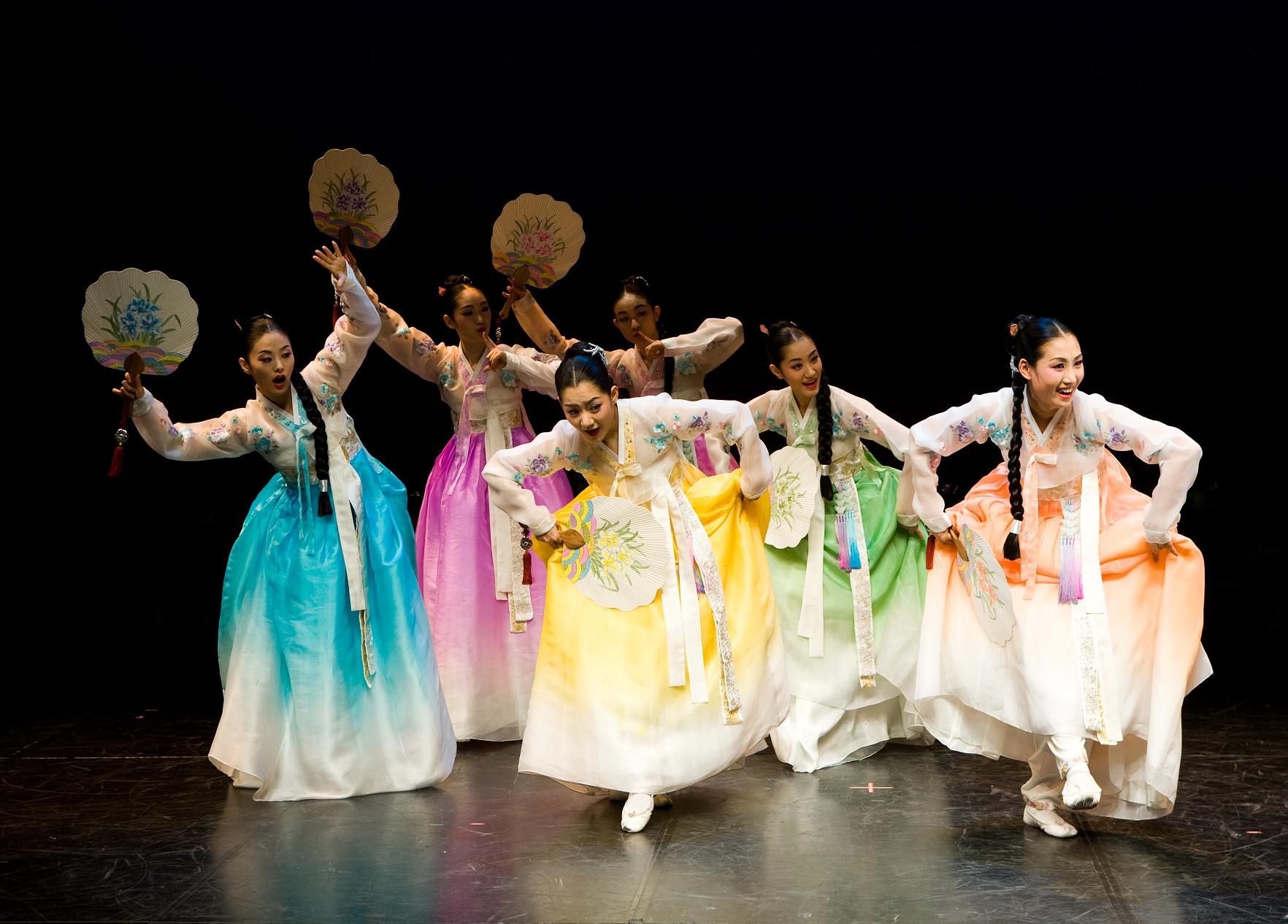Miso: An assortment of traditional performances

Shifting seasons and shedding dialogue
Do not expect a conventional musical, though, just because the promotion posters label Miso as a musical. The entire performance is non-verbal except for two songs sung by a semi-narrator in pansori, the Korean equivalent of a western opera. Add to this dancing, a bamboo flute solo, and a gamut of percussion feats, Miso becomes, in truth, a succession of various Korean performances loosely woven into a love story. Rather than mold the distinct performances into a Westernized musical structure, and this arrangement preserves the characteristics of each act.
Instead of dialogue, or musical numbers, it is the change of seasons that propels the plot. Starting from winter, when a graceful girl named Sul-hee first meets a young man and falls in love, Miso traces the couple’s intense feelings for each other until fall culminates with the lovers’ marriage and a buoyant festival.
Not only do Miso’s shifting choreography, lights, and music elegantly echo each season, the images projected upon the folding screen at the back of the stage also make the temporal scenes much more real. Winter’s capricious snow swirls, rosy spring blossoms, summer storms, and autumn’s golden harvest fade in and out on the vicarious window for the audience to visually appreciate the passage of time.
Dancing to winter, spring, summer
The dance choreography signifies such shifts in season and relationship with stunning grace. In winter’s snowflake dance, the two young lovers glide across the floor, a blue spotlight shadowing each move. Five or six other dancers hold bouquets of white feathers and swirl in tandem to soft drum rolls as the couple flit through the snow flurry of figures.
Under the bluish light, this arresting image of lovers frolicking under falling snow is echoed twice more. First is at the end of spring, but the duet’s movements are jerkier and rougher, foreshadowing their imminent separation. This time gloomy rain falls, replacing the innocent snow.
Separation is brief, however, since summer heralds a reunion. A green meadow and a full moon are projected on the folding screen. Blue spotlight floods the stage again, but speckled with kaleidoscopic white lights, the atmosphere is dreamy as Sul-hee and her lover embrace.
… and fall: the finale
Whereas most of winter, spring, and summer are dedicated to the enthralling love duet through soft music, pools of light, and slight figures moving through the stage in restrained passion, fall is much more flamboyant. After the lovers get married, the percussion quartet samulnori splashes the production’s finale with hilarious vigor. Humor has traditionally been an essential part of samulnori performances, and this group is no exception. These performers joke, mime, and bob their heads, rotating long, white ribbons attached to their hats. If western plays and musicals are characterized by spectators who remain seated and admire the actors on stage from afar, Korean performances traditionally have the spectators bustling around with the performers. There is no stage. Bystanders are sometimes swept into the performance, allowing people to boisterously sing and dance along with the performers. From wildly exaggerated gestures, pulling volunteers out from the observing crowd, and dancing crazily to heavy drum beats, the samulnori brings Miso to life, giving the audience an opportunity to become part of the show.
Aside from the comic percussion finale, the musical provides various events for audience participation. From 7:00 to 7:30pm, a Jang-gu, or small drum, lesson is given by a Miso performer. Royal Korean traditional costumes are also available for spectators to try on and take photographs an hour before the performance. After the musical itself, all of Miso’s performers file out into an open space outside where the audience can take photos with their favorite performer. Everyone then performs a short Ganggangsullae together.
* * *
Two years have passed since the musical came out as Miso, but in truth, its runtime spans 12 years. Initially the performance was staged with the rather honest moniker, Traditional Culture Stage. At this primal phase, individual performances such as pansori and samulnori were performed in disconnected segments. But a “simple plot introduced into Miso bound the segments together so that audiences could engage themselves to the musical,” says Yuyu (Director, Performance Planning Div.). Perhaps it is still too simple. The lovers separate ever so briefly and without any apparent reason; lacking drama, the performances at one point seem like a jaded procession of routines. But then again, as a mostly non-verbal performance, the simplified storyline lends itself to a wider interpretation of Sul-hee’s expressions and movements. With rich costumes, candid humor, and traditional performances, Miso gives the audience exquisite visual pleasure - or at the very least, some hearty laughs.
Box 1.
Interview with Kim Ji-young (Main dancer)
What is the most difficult scene for you in Miso?
Duets are more challenging, since there isn’t anyone else to fill up the stage. Everything is concentrated to the movements of just the two people. Besides that, the scene that comes right after the lovers’ separation is challenging. It is extremely brief, less than a minute, but I have to convey a complicated mixture of grief and longing.
What is, in your opinion, the difference between Western dance performances and the Korean?
I think it is where you place the center of your body that differentiates Western dancing most from Korean. In ballet, for example, you are always told to raise your body up, up, up ? toes up, chins raised. In Korean dancing however, you are constantly instructed, “down, down.” Your focus is on the lower body, not the upper.
Box 2.
Miso
Genre: Korean musical
Place: Chongdong Theater Traditional Stage, Myeong-dong
Date: Performed daily at 8:00pm, except on Mondays
Price: R: 40,000, S: 30,000, A:20,000. (50% discount if bearing student ID card)

